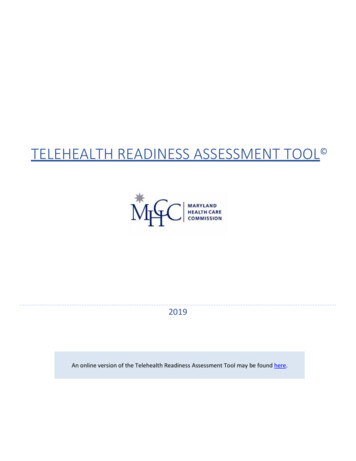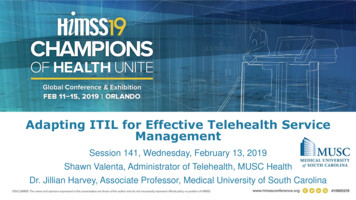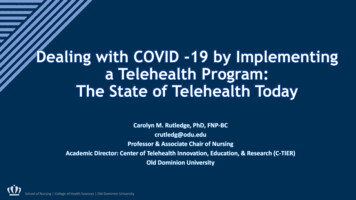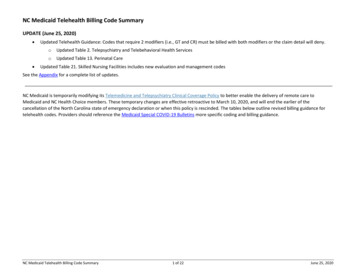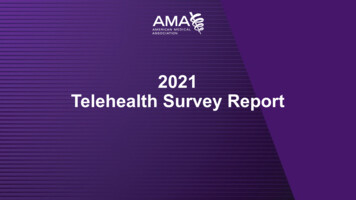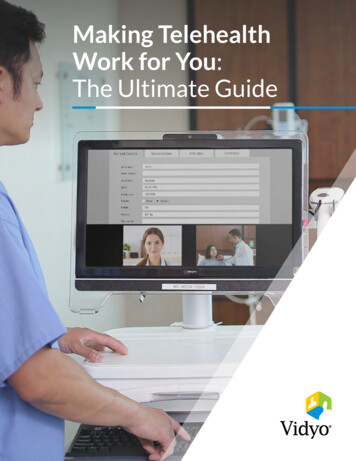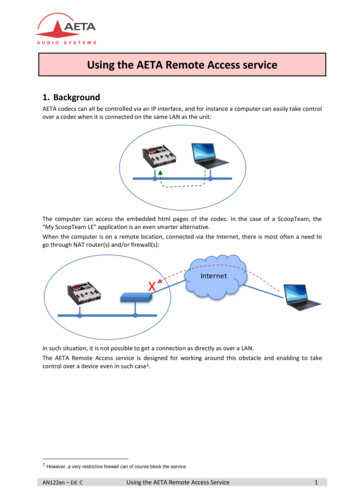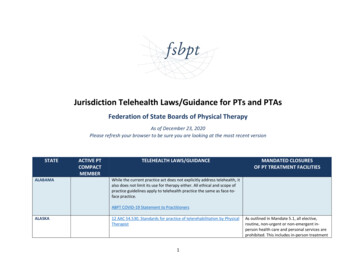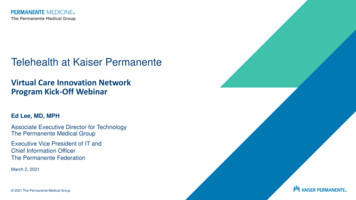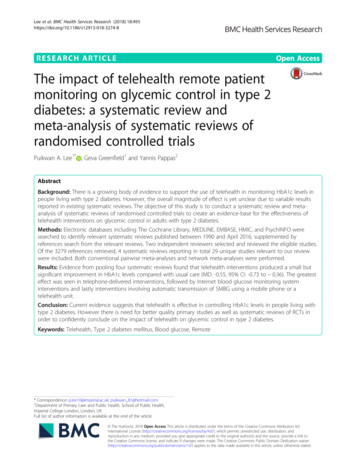
Transcription
Lee et al. BMC Health Services Research (2018) EARCH ARTICLEOpen AccessThe impact of telehealth remote patientmonitoring on glycemic control in type 2diabetes: a systematic review andmeta-analysis of systematic reviews ofrandomised controlled trialsPuikwan A. Lee1* , Geva Greenfield1 and Yannis Pappas2AbstractBackground: There is a growing body of evidence to support the use of telehealth in monitoring HbA1c levels inpeople living with type 2 diabetes. However, the overall magnitude of effect is yet unclear due to variable resultsreported in existing systematic reviews. The objective of this study is to conduct a systematic review and metaanalysis of systematic reviews of randomised controlled trials to create an evidence-base for the effectiveness oftelehealth interventions on glycemic control in adults with type 2 diabetes.Methods: Electronic databases including The Cochrane Library, MEDLINE, EMBASE, HMIC, and PsychINFO weresearched to identify relevant systematic reviews published between 1990 and April 2016, supplemented byreferences search from the relevant reviews. Two independent reviewers selected and reviewed the eligible studies.Of the 3279 references retrieved, 4 systematic reviews reporting in total 29 unique studies relevant to our reviewwere included. Both conventional pairwise meta-analyses and network meta-analyses were performed.Results: Evidence from pooling four systematic reviews found that telehealth interventions produced a small butsignificant improvement in HbA1c levels compared with usual care (MD: -0.55, 95% CI: -0.73 to 0.36). The greatesteffect was seen in telephone-delivered interventions, followed by Internet blood glucose monitoring systeminterventions and lastly interventions involving automatic transmission of SMBG using a mobile phone or atelehealth unit.Conclusion: Current evidence suggests that telehealth is effective in controlling HbA1c levels in people living withtype 2 diabetes. However there is need for better quality primary studies as well as systematic reviews of RCTs inorder to confidently conclude on the impact of telehealth on glycemic control in type 2 diabetes.Keywords: Telehealth, Type 2 diabetes mellitus, Blood glucose, Remote* Correspondence: p.lee10@imperial.ac.uk; puikwan 81@hotmail.com1Department of Primary Care and Public Health, School of Public Health,Imperial College London, London, UKFull list of author information is available at the end of the article The Author(s). 2018 Open Access This article is distributed under the terms of the Creative Commons Attribution 4.0International License (http://creativecommons.org/licenses/by/4.0/), which permits unrestricted use, distribution, andreproduction in any medium, provided you give appropriate credit to the original author(s) and the source, provide a link tothe Creative Commons license, and indicate if changes were made. The Creative Commons Public Domain Dedication o/1.0/) applies to the data made available in this article, unless otherwise stated.
Lee et al. BMC Health Services Research (2018) 18:495BackgroundDiabetes is a serious, chronic condition that is recognised as an important cause of premature death anddisability worldwide. In particular, the prevalence oftype 2 diabetes is emerging as one of the greatest global public health challenges in twenty-first century[1]. In the UK, the National Health Service (NHS)spends around 9.8 billion a year on diabetes. Mostof this cost (80%) is spent on treating complicationsalone as a result of poorly controlled diabetes, ofwhich many are possibly preventable [2]. These couldinclude blindness, kidney failure, heart attacks, strokesand amputations [2]. Diabetes UK warned that “diabetes is threatening to bankrupt the NHS after a 60%rise in cases in the past 10 years”. The cost of treating diabetes complications is also expected to almostdouble by 2035/6 if no actions are taken to preventthese complications [3]. The urgent need for improvements in effective management of diabetes and preventing its complications is therefore evident.The aim of diabetes management is to keep bloodsugar levels as close to normal as possible to improvesymptoms and minimise the risk of long-term complications [4]. This requires close monitoring of vital signsand effective working relationship between the patientand their healthcare professionals. The provision of conventional outpatient care alone, which generally occursless than 3 times a year [5], is therefore not sufficient.There is a growing body of evidence that supportsthe uses of advanced and innovative technologies,such as telehealth, to monitor and manage peoplewith diabetes at a distance and as frequently as it isneeded [5–7]. Telehealth is generally described as theexchange of medical information from one location toanother using electronic communications or digitaltechnologies, such as desktop, laptop, mobile phonesand other wireless tools [8].Overall, existing evidence suggests that telehealth hasthe potential in improving HbA1c for patients livingwith diabetes but the overall magnitude of effect is unclear due to variable results reported in existing systematic reviews. Given that the literature already containsmultiple systematic reviews on telehealth and type 2 diabetes [7, 9, 10], there is an opportunity to pool the evidence from all existing reviews to report an estimate ofeffect. Therefore, to create an evidence base for the effectiveness of telehealth on glycemic control in type 2diabetes, we conducted the first systematic review ofsystematic reviews and meta-analyses of randomisedcontrolled trials (RCTs) to assess the evidence of the effects of telehealth interventions on glycemic control inpatients living with type 2 diabetes.For the purpose of this study, we defined telehealth asremote patient monitoring (RPM), which involves thePage 2 of 10transmission (electronic or verbal) of self-monitoredblood glucose (SMBG) readings to a healthcare professional or a specialist team at an offsite monitoring centerfor evaluation and feedback.MethodsInclusion criteriaStudies that met the following criteria were included inthis review: i) systematic reviews and/or meta-analysesof RCTs with our definition of telehealth as an intervention; ii) adults 18 years of age with a diagnosis of type 2diabetes; iii) comparison of standard outpatient care(usual care) or other RPM telehealth interventions; andiv) reported HbA1c outcome. Systematic reviews and/ormeta-analyses of RCTs on RPM telehealth interventionswere excluded if they: i) were non-English publications;ii) included a mixed study population (type 1 and type 2diabetes) and results were not reported separately fortype 2 diabetes; or iii) do not provide feedback topatients following the transmission of SMBG data. Insystematic reviews where RPM telehealth was one partof a wider intervention, these were only included wherethe effects of the RPM telehealth component were individually reported. In addition, if the same authors hadproduced several publications of the same review, themost updated and/or the full report of the review wereincluded, and other versions excluded.Search strategyThe literature search was conducted from April 1 to 8,2016 and the electronic bibliographic databases including The Cochrane Library, MEDLINE, EMBASE, HMICand PsychINFO were searched. All searches were restricted by date range to 1990 – April 2016. Limiting thesearch period from 1990 is likely to identify all apartfrom a very small minority of systematic reviews thatwere carried out earlier [11, 12]. A base strategy (seeAdditional file 1) was developed in MEDLINE (Ovidinterface). This strategy was then converted to runeffectively in other databases using different interfaces.Reference lists of all potentially relevant systematicreviews identified by the electronic searches were alsochecked for any eligible reviews that have not beenidentified in the search.Study selection and data extractionBased on the eligibility criteria, two reviewers (AL andYP) independently screened the list of titles/abstractsidentified through searches for systematic reviews.Selected systematic reviews at this stage were furtherincluded for a full-text review by the same two reviewers. Any disagreements between the reviewers aboutthe inclusion and exclusion were resolved by discussionuntil a consensus was reached. The same two reviewers
Lee et al. BMC Health Services Research (2018) 18:495using Eppi-Reviewer software 4 then extracted data fromthe resulting final list of selected systematic reviews independently. The two sets of extracted data were thencompared for quality and validity purposes. Consensuswas achieved without negotiation.Assessment of risk of biasThe assessment of the methodological quality andstrength of each systematic review was based on theAMSTAR tool, which is a validated measurement toolavailable for evaluating multiple systematic reviews [13].The AMSTAR tool is a questionnaire that comprises of11 criteria, which specifically assess the presence of: i)an a priori design; ii) duplicate study selection and dataextraction; iii) a comprehensive literature search; iv) theuse of status of publication as an inclusion criteria; v) alist of included/excluded studies; vi) characteristics of included studies; vii) documented assessment of the scientific quality of included studies; viii) appropriate use ofthe scientific quality in forming conclusions; ix) the appropriate use of methods to combine findings of studies;x) assessment of the likelihood of publication bias; andxi) documentation of conflict of interest [14].Each of the 11 items is given a score of 1 if the specificcriterion is met by a “yes” answer, or a score of 0 if thecriterion is not met, unclear or not applicable. The overall AMSTAR score is calculated by adding all the individual item scores together. As defined by AMSTAR,quality is categorised into three levels: high quality if thetotal score is between 8 and 11, medium quality if thetotal score is between 4 and 7, and low quality if thetotal score is between 0 and 3.The same two reviewers independently assessed eachpotentially relevant review for inclusion. Any disagreements between the reviewers were resolved by discussion and when required, a final opinion from a thirdreviewer was sought.Data analysisTo examine the overall magnitude of effect in using telehealth for controlling HbA1c levels in Type 2 diabetes,where possible, we conducted conventional pairwisemeta-analyses as well as network meta-analyses (NMAs)of the included reviews. While the pairwise meta-analysesallowed us to investigate the difference of effect betweentelehealth interventions vs. usual care, the NMAs enabledus to explore if there is any specific telehealth applicationthat is superior. NMAs involve the statistical combinationof both direct and indirect evidence about pairs of interventions that originate from two or more separate studiesto provide estimates of relative effectiveness for allcomparators.Care was taken to not include data from individual studiesmore than once by unpicking each of the included reviewsPage 3 of 10and the subsequent combination of data of the individualprimary studies included in the reviews. For HbA1c, wherechange from baseline data were reported in the trials andwere accompanied by a measure of variation (for examplestandard deviation), these were extracted and used in themeta-analyses. Where measures of spread for change frombaseline values were not reported, these trials were excludedfrom the meta-analyses.Furthermore, due to the various telehealth applications(technologies) used as well as feedback methods provided in the interventions, we performed subgroupmeta-analyses to assess whether their impact on glycemic control differed.The conventional pairwise meta-analyses were conducted with reference to the Cochrane Handbook forSystematic Reviews, whereas NMAs were undertakenusing the Netmeta package in R3.2.2. This uses agraph-theoretical method, which is mathematicallyequivalent to the frequentist network meta-analysis[15]. Heterogeneity was assessed using the overall I2value for the whole network, which is a weightedaverage of the I2 value for all comparisons wherethere are multiple trials (both direct and indirect),and random-effects models were used if the I2 valuewas above 50% (as for pairwise meta-analyses, this wasinterpreted as showing the assumption of a shared underlying mean was not met, and therefore a fixed-effectsmodel was inappropriate). A funnel plot generated inReview Manager 5 (RevMan 5) for HbA1c was used tovisually assess publication bias.Items on the PRISMA (Preferred Reporting Items forSystematic Reviews and Meta-Analyses) checklist that isrelevant for a systematic review of reviews was used toreport the findings (see Additional file 2).ResultsSearch resultsThe systematic literature search identified in total 3279potentially relevant studies. After removing duplicatestudies, 3201 studies were screened on their titles andabstracts for relevance. In total, 3143 were excluded because they were not systematic reviews or meta-analyses,or did not include telehealth interventions or a population with diabetes. For the remaining 58 studies, full textarticles were obtained and reviewed against the inclusionand exclusion criteria. Overall, 54 studies did not meetthe eligibility criteria such as being a systematic reviewand/or meta-analysis of RCTs, including telehealth interventions that met our definition of telehealth, and/orreporting Type 2 diabetes results separately. These studieswere therefore not included in this review. A detailed listof excluded studies and reasons for their exclusion is provided in an additional file (see Additional file 3). Figure 1provides the systematic review of reviews study flow chart
Lee et al. BMC Health Services Research (2018) 18:495Page 4 of 10Fig. 1 PRISMA flow diagramthat demonstrates the inclusion and exclusion process andresults.In total, four systematic reviews and/or meta-analysesmet the inclusion criteria and were included in this review. Summaries of these are presented in evidence tables (see Additional file 4). The included reviews werepublished between the years 2009 and 2015. Only onereview conducted meta-analyses [7].The reviews we included and coded only assessedstudies with an RCT design. Two of the four reviews included both type 1 and type 2 diabetes but only data fortype 2 diabetes was used in this review.Although all four reviews focused on determining theeffectiveness of telehealth applications for individualswith diabetes, the scopes of the reviews varied. One review solely targeted telehealth remote patient monitoring interventions that incorporated key elements ofstructured self-monitoring of blood glucose [16].Another review only focused on telehealth interventionsin patients with type 2 diabetes and inadequate glycemiccontrol [7]. For the remaining two reviews, one includedstudies using cell phones and wireless devices only [17],and the other one looked at studies on Internet bloodglucose monitoring systems only [18]. Furthermore, oneof the four reviews only included patients with type 2diabetes using insulin [18], two reviews included bothinsulin- and non-insulin-dependent patients with type 2diabetes [16, 17] and one review provided no details onthis [7]. The two reviews that included a mixed population of insulin- and non-insulin-dependent patients didnot report any results separately for the two groups.In total, we found 78 studies coded in the four reviews,of which 51 were considered relevant to our review.Individual telehealth interventions that were deemed irrelevant and excluded included studies that did not involve or report results separately for participants withtype 2 diabetes, studies that did not include telehealthinterventions that met our review’s definition of telehealth or studies that did not involve the transmission ofSMBG data followed by automatic and/or healthcareprovider feedback. The 51 relevant studies contained 16duplicates and four studies also had multiple publications (n 10); thus, we identified in total 29 uniquestudies relevant to our review. However, four of thesestudies did not provide extractable data for HbA1c andwere therefore not included in our meta-analyses. The
Lee et al. BMC Health Services Research (2018) 18:495number of relevant trials included in each review rangedfrom five to 18 trials and the sample sizes of the varioustrials ranged widely from 30 to 1665 participants. Thelength of the interventions ranged from 3 to 60 months,with majority of the interventions lasting three months(13/29 studies) or between six and 12 months (13/29studies). Only one study reported a five-year follow-up.Moreover, studies also varied in intervention complexity; nearly half of the studies involved automatic transmission, where self-monitored data are transmitteddirectly and automatically to a receiving station withoutinterruption. This typically involves patients using eithera mobile phone with a diabetes management softwareinstalled and connected to a blood glucose meter or atelehealth unit that is connected by a secure computernetwork at home. Approximately one third of studiesused the Internet or a website to deliver self-monitoredblood glucose results and self-management information.Lastly, there were also some interventions delivered bytelephone. Telephone-delivered interventions do not require patients to electronically transmit their daily bloodglucose readings to their healthcare professionals.Instead, they typically require patients to log their bloodglucose levels daily and a healthcare professional wouldfollow up with a telephone call weekly to review theblood glucose log and discuss the glucose values withthe patients.Moreover, when it came to providing feedback to patients; majority of the interventions provided feedback atleast once daily, if not more, using one or a combinationof feedback methods including, SMS or text messagingto the patient’s mobile phone, messaging through internet, telephone calls and/or secure messages via a patientportal or through a telehealth system. Majority of thefeedback was provided by a healthcare professional butnearly half of the studies provided automatic feedbackgenerated from computer algorithms, without providerinput. Only one study utilised videoconferencing as away of delivering feedback to patients and three studiesonly contacted patients with feedback if necessary (i.e.when blood glucose levels were not within normalrange). In addition to the wide range of technologiesused, many of the studies also incorporated an educationalcomponent to their telehealth intervention to improvepatients’ knowledge in diabetes self-management.Almost all studies indicated that the transmittedself-monitored blood glucose data were used to provide feedback, or modify treatment or behavior, although the details varied.For the purposes of subgroup meta-analyses, telehealthapplications and feedback methods were classified intodifferent categories. For telehealth applications, these weregrouped into four categories according to the method oftransmission used for transmitting self-monitored data toPage 5 of 10a receiving station remotely: (i) Internet/web (includingany application or software on a computer or a mobilephone that uses data networks or the Internet); (ii) automatic transmission (including the use of any telehealthunit placed at home that automatically and directlytransmit data upon taking measurements); (iii) automaticmobile transmission (including the use of any telehealthequipment that allows for the direct transmission ofself-monitored data on the move, without interruption);and (iv) telephone (interventions delivered by regular telephone calls from a healthcare professional, no electronictransmission of data involved).With regards to feedback methods, six categories wereclassified: (i) automated message (automated messaginggenerated from computer algorithms, without healthcareprovider input); (ii) human calls (interactive telephonecalls with a healthcare provider or researcher); (iii) human calls only if necessary (i.e. interactive telephonecalls with a healthcare provider only when blood glucoselevels were outside of normal range); (iv) human message (personalised feedback via messaging from a healthcare provider); (v) human message calls (personalisedfeedback via messaging from a healthcare providerfollowed up by an interactive telephone call); and (vi)videoconferencing (use of video telecommunicationtechnologies which allow the patient to communicate inreal-time with a healthcare provider at a distance).Automated and human messages could include messaging through Internet, SMS, a patient portal and/or atelehealth system.Quality assessment of reviews and meta-analysesAmong the four systematic reviews described in thecurrent review, two were rated moderate quality reviews[7, 17]. The methodological quality of the remaining tworeviews [16, 18] was considered low according to theAMSTAR tool (total score of 1 and 2, respectively). Themost common methodological weaknesses were lack ofincluding an ‘a priori’ design, a list of both included andexcluded studies, and a search for “grey literature or unpublished literature” and/or detail the source of funding/support for the systematic review and for each of the included studies. For the two reviews that scored a lowrating, in addition to the above, the authors did not provide details on whether they performed duplicate studyselection and data extraction procedures nor include theuse of any quality scoring tool or checklist. Furthermore,three of the four included reviews were also of qualitative nature; hence further 2 out of the maximum 11points were lost due to the lack of any statistical poolingof results and statistical assessment for the presence ofpublication bias. The reason for not conductingmeta-analyses in the three qualitative reviews was notdescribed.
Lee et al. BMC Health Services Research (2018) 18:495In the two reviews [7, 17] that used a quality scoringtool (Downs and Black score and Jadad score, respectively) to assess the scientific quality of their includedRCTs, 18 out of 25 studies were rated as moderate/goodquality. The remaining five RCTs were rated as low quality based on the Jadad score.Effectiveness of telehealth interventions in type 2diabetesAll four reviews primarily examined the effect of telehealth on HbA1c. Russel-Minda et al., 2008 reportedthat three out of their five studies on type 2 diabetesusing cell phones with SMS and Internet (some withnurse-directed educational component) found a statistically significant improvement in HbA1c when comparedto usual care. Tildesley et al., 2015 who identified ninerandomised controlled Internet blood glucose monitoring systems (IBGMS) trials, reported that eight of themshowed significantly improved HbA1c levels in theIBGMS group when compared with the usual caregroup. However, one of the studies only achieved significant HbA1c reduction at six months but not 12 months.Greenwood and colleagues (2014) identified and reviewed16 teleheatlh remote patient monitoring interventionsusing one or a combination of technologies (includingtelephone, mobile phone, wireless device, telehealth unitand/or internet), that incorporated key elements of structured self-monitoring of blood glucose (SMBG) identifiedas essential for improving HbA1c. They reported that,compared to usual care, telehealth was shown to significantly improve HbA1c in seven out of the 15 reviewedstudies. The authors also found that interventions that incorporated at least five out of the seven key elements ofstructured SMBG consistently achieved significant HbA1cimprovements between study groups. In addition, studiesthat incorporated at least four of the seven key elementsof structured SMBG and had a baseline HbA1c greaterthan 8% resulted in a decrease of at least 0.7% in HbA1clevels. Lastly, Huang et al., 2015 reported that, compared tousual care, 11 out of the 18 studies included in the reviewfound a statistically significant improvement in HbA1c inthe telehealth group. Furthermore, a meta-analysis of the18 studies found that participants using telehealth had significantly improved HbA1c levels when compared to participants receiving usual care (MD 0.54, 95% CI: -0.75to 0.34). The same review also conducted subgroup analyses that included feedback methods, duration offollow-up, study location, baseline HbA1c and sample size.They found that feedback by interactive telephone callswith a healthcare provider or researcher to be associatedwith the greatest improvement in HbA1c (K 1.13; 95% CI,K 1.51 to K 0.75), followed by automated phone-basedSMS and/or internet-based messaging (K 0.36; 95% CI K0.47 to O 0.24). No improvement in HbA1c was reportedPage 6 of 10with automated telephone calls (K 0.01; 95% CI K 0.32 to K0.29). For the remaining subgroup analyses, a significant reduction in HbA1c was reported to be associated with Asianethnic groups, small study sample sizes, and patients with abaseline HbA1c level of 8% or higher.In order to determine the overall effectiveness of telehealth on glycemic control in individuals with type 2diabetes, we conducted additional meta-analyses that incorporated all the unique studies, with extractable dataon HbA1c, identified in the four reviews.A pairwise meta-analysis pooling evidence from 25(out of 29) RCTs indicate that, compared to usual care,telehealth is associated with significant improvements inHbA1c in patients with type 2 diabetes (MD 0.55,95% CI: -0.73 to 0.36) but with statistical heterogeneityto the variability in effect estimate (I2 82%; Fig. 2). Inaddition, although telehealth was statistically better thanusual care in improving HbA1c levels, the confidenceinterval of the mean difference crossed the threshold forminimal clinically important difference (MID) as definedby the NICE guidelines on type 2 diabetes in adults [19].The greatest effect was seen in telephone-delivered interventions (MD 0.83, 95% CI: -1.54 to 0.12),followed by Internet blood glucose monitoring systeminterventions (Internet/web) (MD 0.77, 95% CI: -1.14to 0.40). The effect of automatic data transmissionusing a mobile phone or a telehealth unit was shownto be similar (MD 0.27, 95% CI: -0.51 to 0.03 vs.MD 0.34, 95% CI: -0.48 to 0.20). Moreover, significant heterogeneity was reported in all subgroups exceptfrom the ‘automatic transmission’ subgroup (Fig. 2).A network meta-analysis of the 25 RCTs further indicated that all telehealth interventions provide a significantlowering of HbA1c compared with usual care, with Internetblood glucose monitoring system interventions also providing significantly more lowering of HbA1c than telehealthinterventions using automatic mobile transmission (MD 0.4934, 95% CI: -0.9250 to 0.0619). However, considerable between-study heterogeneity was present (I2 75.3%;see Additional file 5).We also conducted pairwise and network meta-analyseson feedback methods. Evidence from pairwise meta-analysesof 25 RCTs showed that the human calls subgroup was associated with the greatest effect size (MD: -0.98; 95% CI: -1.54to 0.42), followed by human message (MD: -0.69; 95% CI:-1.13 to 0.26) and then automated message (MD: -0.46;95% CI: -0.63 to 0.30) (Fig. 3). Very small effect sizes or noimprovements were reported for feedback via human message calls (n 1), videoconferencing (n 1) and humancalls only if necessary (n 3). This is most likely due to thevery limited number of studies being available in thesesubgroups. Similar results were reported in the NMA (seeAdditional file 6), where significant reduction in HbA1clevels was associated human calls, human message and
Lee et al. BMC Health Services Research (2018) 18:495Page 7 of 10Fig. 2 Pairwise meta-analyses on HbA1c by telehealth applications/ transmission methodsautomated message subgroups when compared with usualcare groups. In addition, the NMA also suggested that feedback provided through human calls and human message tosignificantly improve hbA1c levels compared with feedbackprovided by healthcare providers only when HbA1c levelsfall outside of normal range (MD: -0.9768, 95% CI: -1.7278to 0.2285 and MD: -0.7031, 95% CI: -1.3697 to 0.0365,respectively).Risk of biasA funnel plot generated in Review Manager assessedpublication bias and significant publication bias towardspositive outcomes in the included studies was observed.DiscussionTelehealth, which can be defined as personalised healthcare delivered at a distance, is believed to have the potential to enhance the quality of healthcare. Over thelast decade, there have been numerous studies aimed atassessing the feasibility and effectiveness of telehealthstrategies on the management of diabetes [17]. As thenumber of published telehealth studies began to increase, a plethora of systematic reviews on telehealthinterventions of variable scope and quality, also began toemerge.Hence, in order to create an evidence-base for the effectiveness of telehealth on glycemic control in type 2diabetes specifically, we conducted a review of systematic reviews. Moreover, in order to generate precise andreliable conclusions; we specifically focused on telehealthapplications that involved patients transmitting (electronically or verbally) SMBG results to a receiving station or person to receive automated messages and/orhealthcare provider feedback.Our systematic literature search identified, in total, 58potential telehealth and diabetes systematic reviews butonly four reviews met our inclusion criteria, of whichtwo were of moderate quality and the other two of lowquality according to the AMSTAR tool. All four reviewsconcluded that telehealth interventions have the potential i
monitoring on glycemic control in type 2 diabetes: a systematic review and meta-analysis of systematic reviews of randomised controlled trials Puikwan A. Lee1*, Geva Greenfield1 and Yannis Pappas2 Abstract Background: There is a growing body of evidence to support the use of telehealth in monitoring HbA1c levels in people living with type 2 .


